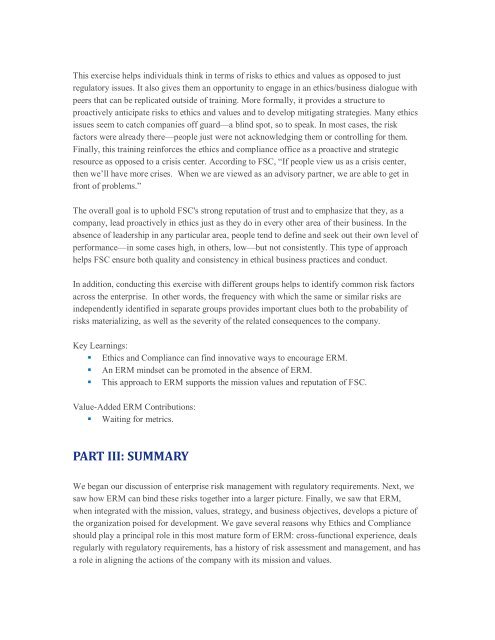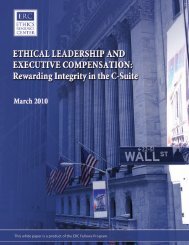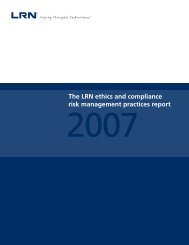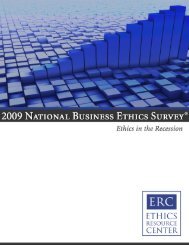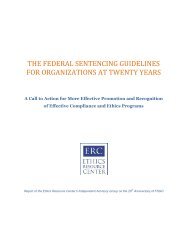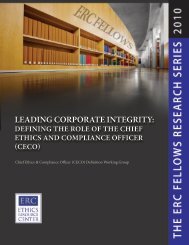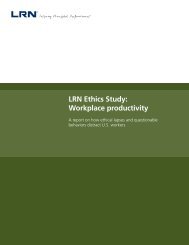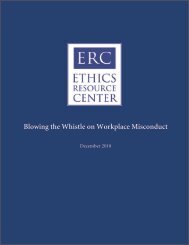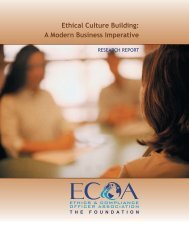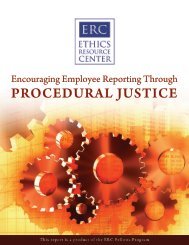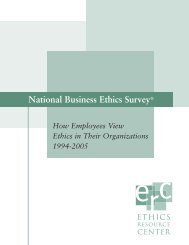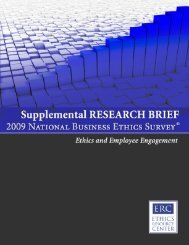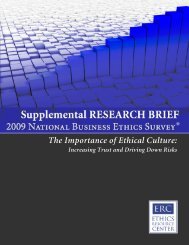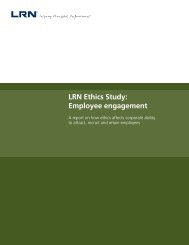enterprise risk management: why the ethics and compliance function ...
enterprise risk management: why the ethics and compliance function ...
enterprise risk management: why the ethics and compliance function ...
Create successful ePaper yourself
Turn your PDF publications into a flip-book with our unique Google optimized e-Paper software.
This exercise helps individuals think in terms of <strong>risk</strong>s to <strong>ethics</strong> <strong>and</strong> values as opposed to just<br />
regulatory issues. It also gives <strong>the</strong>m an opportunity to engage in an <strong>ethics</strong>/business dialogue with<br />
peers that can be replicated outside of training. More formally, it provides a structure to<br />
proactively anticipate <strong>risk</strong>s to <strong>ethics</strong> <strong>and</strong> values <strong>and</strong> to develop mitigating strategies. Many <strong>ethics</strong><br />
issues seem to catch companies off guard—a blind spot, so to speak. In most cases, <strong>the</strong> <strong>risk</strong><br />
factors were already <strong>the</strong>re—people just were not acknowledging <strong>the</strong>m or controlling for <strong>the</strong>m.<br />
Finally, this training reinforces <strong>the</strong> <strong>ethics</strong> <strong>and</strong> <strong>compliance</strong> office as a proactive <strong>and</strong> strategic<br />
resource as opposed to a crisis center. According to FSC, ―If people view us as a crisis center,<br />
<strong>the</strong>n we’ll have more crises. When we are viewed as an advisory partner, we are able to get in<br />
front of problems.‖<br />
The overall goal is to uphold FSC's strong reputation of trust <strong>and</strong> to emphasize that <strong>the</strong>y, as a<br />
company, lead proactively in <strong>ethics</strong> just as <strong>the</strong>y do in every o<strong>the</strong>r area of <strong>the</strong>ir business. In <strong>the</strong><br />
absence of leadership in any particular area, people tend to define <strong>and</strong> seek out <strong>the</strong>ir own level of<br />
performance—in some cases high, in o<strong>the</strong>rs, low—but not consistently. This type of approach<br />
helps FSC ensure both quality <strong>and</strong> consistency in ethical business practices <strong>and</strong> conduct.<br />
In addition, conducting this exercise with different groups helps to identify common <strong>risk</strong> factors<br />
across <strong>the</strong> <strong>enterprise</strong>. In o<strong>the</strong>r words, <strong>the</strong> frequency with which <strong>the</strong> same or similar <strong>risk</strong>s are<br />
independently identified in separate groups provides important clues both to <strong>the</strong> probability of<br />
<strong>risk</strong>s materializing, as well as <strong>the</strong> severity of <strong>the</strong> related consequences to <strong>the</strong> company.<br />
Key Learnings:<br />
• Ethics <strong>and</strong> Compliance can find innovative ways to encourage ERM.<br />
• An ERM mindset can be promoted in <strong>the</strong> absence of ERM.<br />
• This approach to ERM supports <strong>the</strong> mission values <strong>and</strong> reputation of FSC.<br />
Value-Added ERM Contributions:<br />
• Waiting for metrics.<br />
PART III: SUMMARY<br />
We began our discussion of <strong>enterprise</strong> <strong>risk</strong> <strong>management</strong> with regulatory requirements. Next, we<br />
saw how ERM can bind <strong>the</strong>se <strong>risk</strong>s toge<strong>the</strong>r into a larger picture. Finally, we saw that ERM,<br />
when integrated with <strong>the</strong> mission, values, strategy, <strong>and</strong> business objectives, develops a picture of<br />
<strong>the</strong> organization poised for development. We gave several reasons <strong>why</strong> Ethics <strong>and</strong> Compliance<br />
should play a principal role in this most mature form of ERM: cross-<strong>function</strong>al experience, deals<br />
regularly with regulatory requirements, has a history of <strong>risk</strong> assessment <strong>and</strong> <strong>management</strong>, <strong>and</strong> has<br />
a role in aligning <strong>the</strong> actions of <strong>the</strong> company with its mission <strong>and</strong> values.


